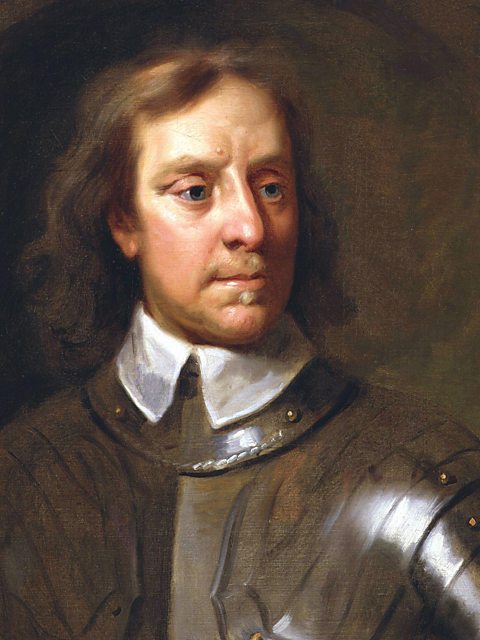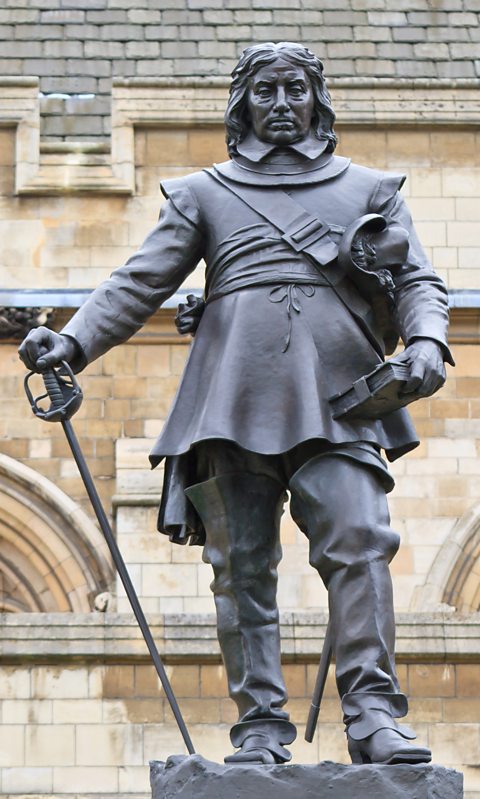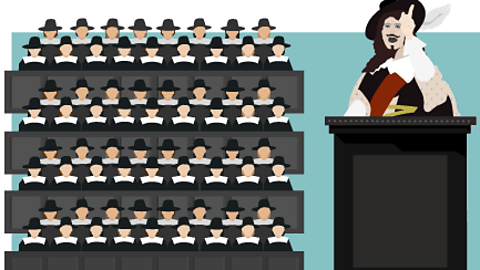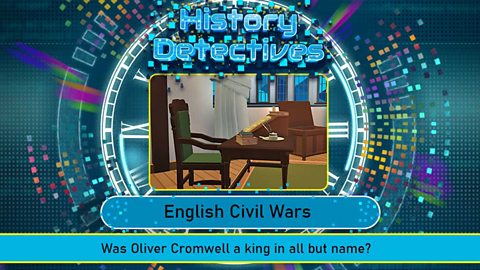Key points
- Following the defeat of King Charles I in the English Civil Wars, and later his trial and execution, Oliver Cromwell became ‘Lord Protector’ in 1653.
- Cromwell was a Puritan, a strict Protestant, and made significant changes based on his beliefs.
- Following Cromwell’s death, there was a growth in support for a return to monarchy. This led to the Restoration, which saw Charles II become king of England.
Game - Oliver Cromwell
Play a History Detectives mission exploring Oliver Cromwell's role after the Wars.
You can also play the full game.
Cromwell's journey to power

Oliver Cromwell was a Member of Parliament. He had been a leader of the Parliamentarian army who, by 1648, had defeated Charles I’s RoyalistA person who supported King Charles I during the English Civil Wars. army in the civil warA war fought between two or more armies from the same country..
Cromwell’s politics were strongly influenced by his religious beliefs. He was a PuritanVery strict Protestants who believed that the Church still required further reform to remove all trace of Catholic practices., which meant he believed that the Bible should be read and studied closely, and that people should spend more time praying and thinking about God. Cromwell wore plain, black clothes and introduced laws to ban popular pastimes, such as bear-baitingA violent sport where a bear was chained to a wooden pole and dogs were set to fight against it., celebrating Christmas and going to the theatre. Puritans believed that entertainment might distract people from their religious duties.

Cromwell's leadership
Following Charles’ arrest at the end of the first Civil War in 1647, there were some in Parliament who wanted to come to an agreement for him to remain as king, but with reduced power. These MPMember of Parliament- a politician who represents a particular area of the country, known as a constituency, and votes on laws. were forced out, and the remaining members, including Oliver Cromwell, formed what was known as the ‘Rump Parliament’. This parliament carried out the trial and execution of Charles I.
Following Charles’ trial, Cromwell was one of only 59 commissionersJudges at the trial of Charles I. They were mainly, but not all, Members of Parliament. who signed his death warrant, in January 1649. The 'Rump Parliament' ruled until April 1653, when Cromwell entered Parliament with 40 soldiers and sent MPs away.
In December 1653, it was decided that England, Scotland, Wales and Ireland should be ruled by one person, as a protectorateThe period from 1653 to 1660 when England, Scotland, Wales and Ireland were ruled as a republic by one leader, a ‘Lord Protector’.. Cromwell was appointed as the ‘Lord Protector’. This gave him many of the same powers Charles had when he was king. A new parliament, sometimes known as the 'Barebones Parliament', was put together to replace the Rump Parliament. It was felt that the Barebones Parliament had too many radical ideas, so they were also dismissed.
In 1657, Parliament actually offered Cromwell the role of king, but he refused. He said he could not accept a role he had spent so long fighting against. Despite not taking the title of king, Cromwell had many similar powers. He was not elected into his position, largely made decisions on his own and was replaced by his son.
To help him rule the country, Cromwell had a close group of advisors to support him. This group was called the Council of State and was set up in 1649.
The period of time that Cromwell ruled England is often referred to as the Interregnum. This ended in 1660, when Charles II was crowned and a monarchy was restored.
After Charles I’s execution, England was known as a commonwealthIn the context of the English Civil Wars, the period between Charles I’s execution and the restoration of the monarchy, when Charles II took the throne. During this period, England (and subsequently Ireland and Scotland) was a republic.. There were still Royalist supporters who were angry about the treatment of Charles.
Ireland
There were also RoyalistA person who supported King Charles I during the English Civil Wars. supporters in Ireland, who wanted to fight for a return to a monarch ruling both Britain and Ireland rather than be ruled by Cromwell. In 1649, Cromwell was nominated by Parliament to lead the New Model Army to Ireland to defeat the Royalists.
In September 1649, Cromwell brutally put down the Royalist uprising in Ireland. His army arrived in Dublin, before defeating opposition at Drogheda and Wexford. This conflict had many casualties. Cromwell and his forces were responsible for a huge number of deaths. Cromwell justified the killing of at least 3,000 Irish soldiers and civilianA person who is not a member of the armed forces, police or actively involved in fighting in a conflict. by arguing that God was on his side. Some historians have suggested that the violence inflicted upon Irish people by Cromwell and his forces was particularly extreme.
Scotland
The Commonwealth also faced a challenge from Scotland. The majority of Scots declared that Charles I’s son, Charles II, was the king. In 1650, Cromwell led an army to invade Scotland to put down this uprising. He won control of Edinburgh, but Charles II and his army invaded England. A battle was fought at Worcester in September 1651, which Cromwell won. Charles II managed to escape and went to the Netherlands. He stayed there until he returned to England to be crowned king, in 1660. Cromwell’s army killed 1,000 men, women and children in Dundee before occupying Scotland and leaving soldiers behind to prevent further uprisings.
Foreign policy
England had started building up overseas colonyA group or country controlled by another country. before Cromwell became leader. He further increased the size of the navy, and ordered them to capture more colonies in the AmericasThe name given to the grouping together of the Caribbean, North, Central and South America..
In 1655 they invaded and took control of Jamaica, which at that point was part of the Spanish Empire. This was a significant event as it resulted in an increase in trade. Sugar was increasingly imported into England and the English started to engage in the transatlantic slave trade, kidnapping and transporting African people across the Atlantic.
Cromwell encouraged Jewish people to move from the Netherlands to England. Jews had previously been persecuted and were forced out of England in 1290, by King Edward I. Many Jewish people who had suffered persecution in Spain and Portugal moved to Amsterdam, which helped to turn the city into one of the world’s busiest ports. This had contributed to the Netherlands’ prosperous economy. Cromwell hoped that these Jewish businesses might bring financial advantages to England, and help the country to rival the Netherlands’ economic success at a time of expanding international trade.
Cromwell's death and the return of the monarchy
Oliver Cromwell died in 1658. He was replaced as Lord Protector by his son, Richard Cromwell. The army was concerned about Richard’s lack of military experience. They did not believe he could rule effectively. Parliament refused to listen to the demands made by the army for reforms.
In 1660, fearing an uprising from the army, Richard Cromwell resigned from his position as Lord Protector. Charles II, the son of Charles I, was invited to return from the Netherlands to be crowned king. This was known as the Restoration. The Interregnum, England’s 11-year period as a republic, was over, and the monarchy was restored.
Charles II’s reign was very different from that of the Puritan Oliver Cromwell. Charles II allowed theatres to reopen; he was a lover of music and the arts. The strict moral rules of the Puritans were relaxed. RestorationThe return of Charles II as king of England, restoring the monarchy after an 11-year period of England being a republic. comedy plays were popular with a public who welcomed the chance to enjoy the theatre once more.
There were also developments in architecture and science under Charles II’s rule. Christopher Wren designed and built St Paul’s Cathedral following the Great Fire of London. In 1662, Charles II supported the foundation of the Royal Society, a group of scientists who held regular meetings to discuss new ideas and their experiments. Christopher Wren was a member of the Royal Society, along with famous diarist Samuel Pepys and scientist Isaac Newton.
Cromwell's legacy

Cromwell is still a divisive figure today.
His actions in Ireland, along with his numerous offensive comments about CatholicA member of the Catholic Church. Catholics believe in having a hierarchy of priests and bishops beneath the Pope, who is the Head of the Church. Members of the Catholic Church also believe in devotion to the saints and the Virgin Mary, Jesus' mother, and in holding Mass. , mean that he is extremely unpopular among many people, particularly in Catholic communities.
In 1661, three years after Cromwell's death, Charles II and his new Parliament ordered the removal of his body from its grave in Westminster Abbey. It was posthumouslyAfter someone has died.‘executed’. Cromwell's body was hanged and his head was cut off and placed on a pole, which was then displayed at Westminster Hall. The ‘execution’ took place on the twelfth anniversary of the day Charles I had been executed.
A statue of Cromwell was erected outside Parliament in 1899.
Historians continue to debate Cromwell’s actions and leadership.

Test your knowledge
History Detectives game. gameHistory Detectives game
Analyse and evaluate evidence to uncover some of history’s burning questions in this game

More on The English Civil Wars
Find out more by working through a topic
- count1 of 3

- count2 of 3

